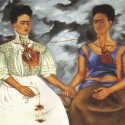Review:
My Brilliant Friend
The Story of a New Name
Those Who Leave and Those Who Stay by Elena Ferante
(Translated by Ann Goldstein)
by Jessi Stevens
—
There is a moment in Elena Ferrante’s cool, candid, and enthralling Neapolitan novels that captures the experience of reading them better, perhaps, than any reviewer ever could. Says narrator Elena Greco of lifelong friend and rival Raffaella Cerullo, “it feels good, sometimes, to hear the mad sound of the brain of one echoing in the mad sound of the brain of the other.” This is exactly how it feels to read Ferrante—to delve into another’s consciousness and listen for the echoes of your own madness. According to Ferrante, this is also the way we interact with those closest to us. Her deeply psychological oeuvre is an extended study in the hazards of intimacy, a great dismantling of the relationships that exist between mothers and daughters; husbands and wives; women and men. Most recently, she’s demythologized female friendship, yielding a rubble of unflattering dialectics: envy and admiration, selfishness and generosity, a narcissism realized in the mirror of the best friend’s face. In her four-volume bildungsroman, the final installment of which will be published this September, Ferrante reveals intimacy to be as selfish as it is twain.
The identity-dependency between Raffaella and Elena, known to intimates as Lila and Lenu, is established in the opening chapters of My Brilliant Friend, when the two first meet while playing dolls in a courtyard of their impoverished, post-war Naples neighborhood. Lila, always a little crueler (and a little more dazzling) than Lenu, abruptly tosses Lenu’s doll through a nearby cellar grate. Lenu, in one of her bolder, more volitional moments in the series, responds by hurling Lila’s doll into the dark after her own. “What you do, I do,” she vows. In many ways, Lenu spends the rest of her life attempting to break this promise and free herself of Lila’s influence.
The relationship that precipitates from this initial exchange is not so much a friendship as a conflation of selves. Lila is an addiction, and Lenu finds that she can no sooner abandon her friend than she can her own essence: “I felt that if I ran away with the others I would leave behind something of mine with her that she would never give back.”
What’s at stake for Lenu is her intelligence, defined vis-à-vis Lila’s. At first, the girls’ intellectual one-upmanship seems empowering, a refuge from the neighborhood’s clannish scheming, exploitation, and economic woe. Poverty lends exigence to their nascent literary ambitions, and the idea of writing novels together becomes an escape plan, a child’s treasure hunt: “We thought if we studied hard we would be able to write books and that the books would make us rich. Wealth was still the glitter of gold coins stored in countless chests, but to get there all you had to do was go to school and write a book.” But after Lila’s father excludes her from this dream by barring her from taking the middle school entrance exams, relentless competition becomes its own form of trauma. Lenu alone rises through high school and university, emerging as an unlikely success onto Italy’s literary scene. The question of what Lila, in elementary school always the better, more brilliant student, might have become casts a shadow over Lenu’s every accomplishment: “My life forces me to imagine what hers might have been if what had happened to me had happened to her, what use she would have made of my luck.” Her relationship to Lila remains predicated on comparison, and, by the end of the third volume, Those Who Stay And Those Who Leave, is reduced to an unfinished syllogism: If you’re not brilliant, then what am I?
This external thrust to the narrator’s inward search marks a departure from Ferrante’s previous work. The cool isolation of Lenu’s interiority will feel familiar to readers, but this time, Ferrante has injected her narrator’s unfiltered solipsism with sociability. Lenu looks outwards in order to look inwards, and the memory of Lila becomes another window into herself.
In establishing this recursive fascination between her dual doyennes, Ferrante captures the voyeuristic current that runs beneath the surface of female intimacy. Narcissism’s grip over the central relationship feels timely and true, especially in the age of social media. Though the series takes place in a pre-Facebook era, one can’t help but recognize that the voyeurism of ogling others’ profiles is reflected in Lila and Lenu’s fraught relationship. Or maybe it’s the other way around. Were Ferrante to comment on the matter, I imagine she’d say that today’s kaleidescopic media outlets only refract insecurities that have always lurked within our relationships to each other.
One of many ways in which Ferrante distinguishes herself from other novelists of the moment is that she chooses to excavate such contemporary themes with antiquated, even ancient tools. Little is known about the Italian author (Elena Ferrante is a nom de plume) other than what she has divulged in scant interviews—she grew up in Naples; she is, like Lenu’s husband, a classics scholar; her primary literary influences include Elsa Morante and Virginia Woolf—but the traces of this skeletal biography show. In addition to what feels like a very contemporary species of voyeurism, the Neapolitan novels are a meld of Aristotelian catharsis, Morante’s fierce historical fiction, and Woolf’s modernist preoccupation with interiority.
Through the lens of Lenu’s obsession with her friend’s squandered potential, Lila’s every ability and Lenu’s every insecurity are magnified; The Story of a New Name is buoyed by an almost mythic, fabulist quality, as Lila is transformed into a chimerical figure of uncanny talent and beauty. Though she possesses only an elementary school education, Lila proves a natural hand at shoe design, politics, literature, chemistry, even Latin and Greek. Just after she is withdrawn from school, she writes a novel, “The Blue Fairy,” so lovely and true that, a decade later, it becomes the inspiration for Lenu’s own literary debut. Ferrante is aware of the potential distortions of recall, and at times prefaces anecdotes of Lila’s intelligence with an authorial warning: “The story of the facts,” she admits, “has to reckon with filters, deferments, partial truths, half lies.” The particular filter of Lenu’s memory seems to inflate and exaggerate her best friend’s brilliance, while diminishing her own.
But perhaps this distortion is only the retrospective effect of emotional trauma, further hinted at in the prose. For all her exaggerations, Ferrante never apologizes, never sugarcoats. Her prose is disarmingly frank, and the dissonance between the cool, rhythmic narration and the violent content it relates suggests the equanimity of someone who has lost the capacity for shock. The novels’ many fracases are leveled off in the plainspoken cadence of memoir, a brisk, synoptic mode that precludes extended scene work or description. Ferrante is at her best when condensing great swaths of time and action into unceremonious, sentence-long curios. In The Story of a New Name, a rushed account of Lenu’s first two years at university is cinched to a close as follows:
This is more or less what happened to me between 1963 and 1965. How easy it is to tell the story of myself without Lila: time quiets down and the important facts slide along the thread of the years like suitcases on a conveyor belt at an airport; you pick them up, put them on the page, and it’s done.
In the opening chapters of My Brilliant Friend, the near-death of a neighbor is abbreviated with the same calm:
One of the many terrible scenes of my childhood begins with the shouts of Melina and Lidia, with the insults they hurl from the windows and then on the stairs; it continues with my mother rushing to our door, opening it, and looking out, followed by us children; and ends with the image, for me still unbearable, of the two neighbors rolling down the stairs, entwined, and Melina’s head hitting the floor of the landing, a few inches from my shoes, like a white melon that has slipped from your hand.
These elisions and truncations draw the narrative away from scene and into Ferrante’s trademark interiority, the most defining and captivating feature of her work—the worlds of her novels are winnowed through the inner machinery of memory. Through the transparent screen of Ferrante’s prose, Lenu narrates from some dark confessional of the mind, as if purging herself of the story that she tells. The reader, in turn, is captivated—who isn’t fascinated by other people’s sins? Even still, given the damning material that Lenu divulges (more than once, she wishes Lila were dead) one also has the sense that these are admissions we shouldn’t overhear. In this way, the relationship between reader and narrator mirrors the central friendship of the series. As Lenu falls for Lila, we fall for Ferrante: at first hesitantly, even reluctantly; though in the end, she captures us completely.
Ultimately, Ferrante’s brand of solipsism is rooted in contingency. With every confession, Lenu sheds another layer of her past, denouncing scholarship, marriage, politics, and friendship, arriving at last at the threshold to the temple of the self: “I sunk inside myself, inside my flesh, which seemed to me not only the sole dwelling possible but also the only material for which it was worthwhile to struggle.” But embedded within this essential “material” of herself, Lenu, paradoxically, finds Lila: “Her life continuously appears in mine, in the words that I’ve uttered…in a particular gesture that is an adaptation of a gesture of hers, in my less which is such because of her more, in my more which is the yielding to the force of her less.” To the series’ many merits—the captivating storytelling, the brutal honesty, the feminist overtones—we might add that here, Ferrante has not only inverted the narcissism of introspection, but equated it with friendship.
Once again, Ferrante has gathered the unspoken flotsam that litters the mind of every wife, mother, and friend, and made of it a novel. You may not like what she has to say. But like Lila, she remains a woman to be reckoned with. These new and ever-ferocious books secure Ferrante’s position as a contemporary master of interiority, and prove that her talents extend to rendering sociability as well, however suspicious of relationships her fierce, intelligent female leads remain. In the end, the most one can say of this brilliant friendship is that each woman demands of the other an excellence no one else would. “What fucking use has it been for me to imagine that you would enjoy a wonderful life for me, too?” Lila reprimands Lenu toward the end of Those Who Stay and Those Who Leave. It is the only way she knows how to say she expected more of them both.
—
Jessi Stevens is an MFA candidate in fiction at Columbia University.



